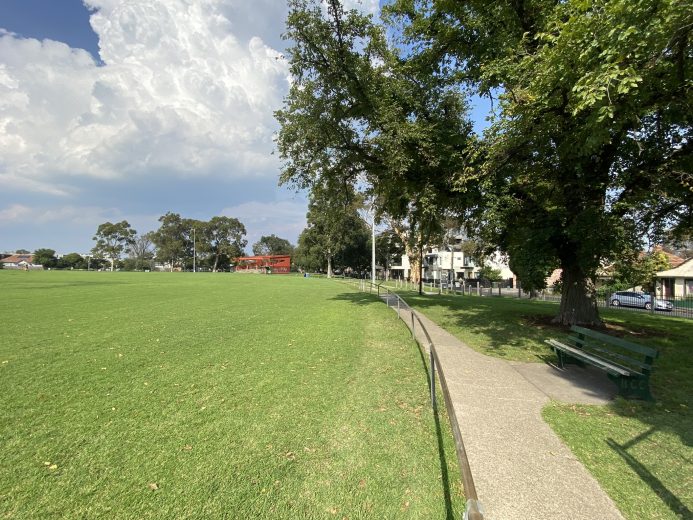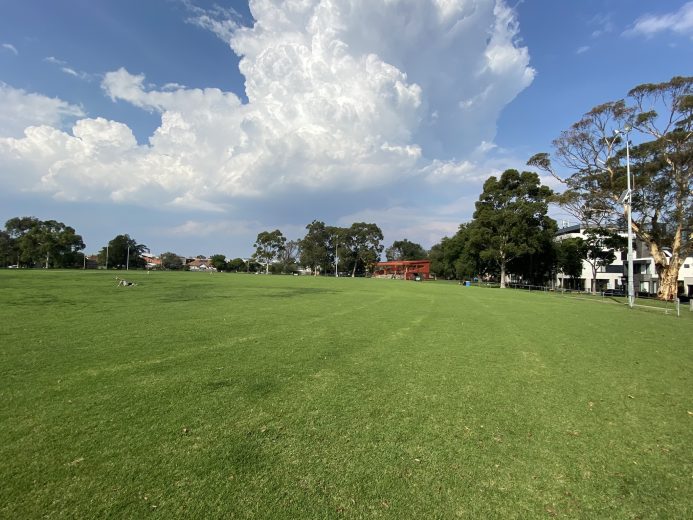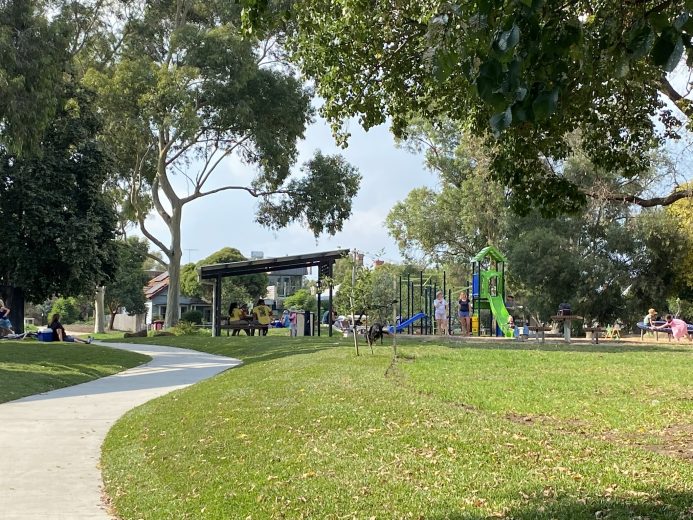- Home
- |
- About us
- |
- News and Events
- |
- Resources
- |
- Contact
- |
- Donate today
- Shop
Areas of interest

During Covid lockdown, I spent a lot of time in the park. Everybody in my suburb was in Fleming Park, near my place. People- and dog-watching were one of my major pastimes.
The rules were broken. Friends met for picnics on the footy oval and under the surrounding trees. They bought takeaway and coffee from the surrounding cafes. There’s a McDonald’s not far away, and a place called, alarmingly, “Fat & Tasty.” There are trendy joints, where the young would normally meet for Sunday brunch. It’s a great park for that, with lots of choice.
It’s a dog park. Suddenly, everyone had a dog. Every breed, from chihuahuas to great danes. They walked them. They let them off the leash. They played with them. Dogs chased each other, sniffed each other’s bums and eyed one another off. The dogs had a wonderful time.
As the title of this story suggests, I’m an amputee. My leg was amputated above the knee rather than below. What might appear as a small detail actually changes someone’s life profoundly. There are many things I simply can’t do – climb a stepladder to change a light globe; carry anything weighing more than about a kilo; change my sheets. (My doona’s too heavy for me to lift.) Just staying upright – let alone walking – requires close attention to the surface I’m on; the direction and force of the wind. Softer surfaces, even carpet and definitely grass, mean I have to balance differently. And I wouldn’t even attempt to walk on sand!
Walking across the oval on the grass is a major challenge. It feels as though I’m on stilts, walking across an old inner-spring mattress that seems to stretch forever. When I reach the other side, I’m flooded with relief. I look for somewhere to sit down.
One day I set out, shaking with trepidation. As usual, I kept my eyes glued to my feet. But, from the corner of my eye, I could see a young man with a large half-grown dog. It was bounding about like a puppy. I gave them a wide berth. In vain. The dog ran towards me, curious. It jumped up. It licked my face. Of course I fell backwards: there was nothing I could do. A small crowd of concerned onlookers gathered. Landing on the soft grass, I wasn’t hurt but I was shaken up. Its owner came over. He was angry. “People like you shouldn’t be allowed in this park!” he shouted. “It’s a dog park.”
A couple of people – not the man responsible – helped me up. They were incensed. I was in a public park, after all, where dogs off the leash are expected to be under someone’s control at all times. I was fine – not even a bruise. I didn’t waste time being concerned. What would be the point?
If I’m not feeling very confident about venturing onto the grass, or if it’s windy, I enlist a passer-by to walk beside me. We make conversation. I feel the need to explain my request. “I’m an amputee, with very poor balance,” I begin.

Nine times out of ten, the automatic response is, “Oh, that’s all right.” In ten per cent of cases, they respond with, “Aw…….aw aw aw” as though they’re talking to a baby.
Think about it: no, it’s not all right. It’s inconvenient, often scary, and very unfortunate. It’s also time-consuming. And I don’t want to be pitied or treated as though I’m a child.
I don’t say this aloud, of course. I engage in appeasement. A series of questions follows.
“How far away do you live?”
“Oh, just down the road.”
“Do you live alone?” They sound anxious.
“Yes. I prefer it that way”, I respond calmly.
They nod. “Do you have family nearby?”
“Not really. My son comes to see me every couple of weeks.” This causes alarm “But if I need something urgently, I have neighbours who help.”
Often, for some reason, the next question is this: “Do you have any pets?”
I turn it into a joke. “No. I’d trip over them!”
Then I change the subject, asking them about themselves. We usually part the best of friends.
I’ve met all kinds. Many have been working from home. They come to the park during their lunch break. There was the Iranian academic from Sydney University, stuck in Melbourne; business executives; a cyber security expert, tradies. Lots of people, it seems, work in “media”, requiring copious knowledge of how computers work. When I told others I was a writer, some confessed to being in the arts: a circus performer, other (would be-) writers, designers, painters, musicians. A snapshot of my suburb’s population these days.
Nowadays not many are from the wave of migrants who moved here in the fifties and sixties. But there are exceptions. Spanish Teresa, who lives in my street, walks round the park too, and we exchange greetings. Her son Oscar is also a neighbour. He helped me when my kitchen was flooded after a huge downpour. Teresa’s husband died in the West Gate Bridge collapse of 1970. She supported young Oscar by working in factories.
Koula lives on the corner. She’s Greek. She’s very old and blind now: she no longer walks in the park with other Greek women, all older, all dressed in black. Her sons Bill and George run the fish shop at a nearby shopping centre.

Because I can’t run around the oval, I’ve spent a fair bit of time just sitting on one of the benches. It’s a great place for people- and dog watching.
Dogs arrive at the park on a leash. Their owner frees them and then often they do their daily poo. The owner always collects this in a plastic bag – conveniently tied to the leash – and finds a rubbish bin. The dog rolls happily (and no doubt relieved) on the grass, shakes and runs around in circles, wagging its tail. Then it sniffs the air, looking for other dogs to play with. Labradoodles, Australian terriers, scary looking, huge dogs – they all behave the same way.
In the middle of the oval the owners gather to chat while the dogs enjoy their freedom. I’m not a dog person, but I’m told that there is a whole dimension of social interaction where people refer to others as, “You know – Kenny’s Mum”, “Prince’s owner”, “the woman with Susie, that poodle”.
Balls, occasional frisbees and sticks play a central role here. Most dogs seem well-trained. They sit, glance up at their human overlords, trembling with anticipation, until the object is launched. Then they dash off, sometimes making a deft catch mid-air. They trot back, place the ball on the ground, sit and wait. They don’t seem to tire of this game. They race each other. But they’re intent on pleasing their master or mistress. It’s not fun for me, the viewer: it’s poignant and a little sad.
Passing dogs sniff my prosthesis in puzzlement. “Sorry,” their owners say. “He’s just friendly!” But it’s not that: they don’t know what to make of me. If I’m walking they bark and stare in fear. What is this strange creature?
If my prosthesis is visible, few people notice it. They focus instead on where they’re going. Occasionally, as they glance in my direction, you see them do a startled double-take. Amputees are rare in Australia now – unlike, say, after the First World War. Most people don’t remember ever seeing an amputee.
Thus people remember me. As I walk, someone proffers a greeting. If I stop, they’ll explain that they’ve seen me before. I’ve long given up feeling guilty that the recognition isn’t reciprocated. Someone told me that his son, who was born without a forearm, has the same experience.
Small children have an interesting reaction to my unusual, swaying gait.
“Mummy, what’s that lady doing?” The mother looks appalled. The child has drawn attention to the fact that I’m different.
“Let me show you my leg,” I say. I pull up the bottom of my pants to reveal the steel shaft, the computer-driven knee, and the blue socket above it. “Do you want to touch it?”
Usually they back off, startled. “It’s not an ordinary leg,” I continue. “But it works fine. It’s a special leg, just for me. Mummy or Daddy will explain it to you.”
Often they ask questions: “Does it hurt?” “Can you jump?” Or, once: “What did the doctor do with your old leg after it was cut off?”
The park is far less peopled since the lockdown finished. My former workmate, Jenny, has vanished; and Virginia, a young woman with an apparent eating disorder. Her sticks of legs carried her round the oval several times a day.
But the park stalwarts remain: Mick and Jim among them. They come here every day – rain, heat, whatever the weather. They arrive around five. They do circuits of the oval like I do. Jim always says g’day. Mick, a retired computer programmer, is always up for a walk across the grass with me. I know a lot about his life and have met most of his family. He got a barbecue last Christmas and his daughter is a police officer. Take an interest in people and they repay you in spades.
But, for me, there are always the few who spoil my day for a moment. Some people – all ages and genders – smile in a patronizing way when they see me. “You’re doing very well!” they say.
I’m afraid I respond. “What do you mean? I’m just walking.”
They’re non plussed. “I mean… you’ve had a stroke, haven’t you?”
“No. I walk funny because I’m an amputee. I’ve been doing this for over ten years. It’s just how I walk.”
They hurry off, embarrassed.
I overhear snatches of people’s conversations. Two older blokes sitting at a table: “…So she bought a hovercraft…”
“What?”
“Oh sorry, I mean one of those drones….”
One day I bumped into someone I knew. He was having lunch on the grass with his family. He introduced me to his son-in-law, who is a lecturer in Prosthetics at La Trobe University. Now a story I wrote about my prosthesis is used as a teaching tool in the La Trobe University Prosthetics course.
I got chatting to Dave in the park. We talked about what it’s like to be an amputee. He works for The Guardian. I emailed him the piece of writing that will be used at La Trobe. In a briefer form it appeared in The Guardian. That’s quite something for a writer like me.
Recently I sat down on a seat next to Alex, an Open Space Planner with my local council. We talked about my difficulties walking in the park. We discussed the camber of footpaths; the problems presented by bluestone, tree roots and the height of the kerb. He was particularly interested to see this story you’re reading now.
Fleming Park for me has an added dimension. My leg – or the lack of it - adds to my experience. In some ways it’s richer now. I’ve learnt how to communicate with people in a new way. I’ve met people I’d never have met. Every day the people I meet bring something unexpected and, in its own way, interesting.
I see how most-able bodied people, unless they’re with friends or family, experience the park in their own bubble. They run; they walk the circuit of the oval, they walk a dog. I go there to exercise by walking, ever-careful and tentative about my steps. Otherwise I’m open to whatever the place brings me.
Something sudden and entirely unexpected led to my amputation. My immediate thought, on hearing what was about to happen, was this: fate has shifted the goal posts on me; life will be different now. In some ways it will be more interesting. And it is.
I’d have my leg back in an instant: who wouldn’t? But perhaps – perhaps – I wouldn’t change things.
Jane has worked in the union movement; as an adviser to a Labor front-bench politician; and as a consultant in education policy. These days, she's a writer. She lives in Melbourne.
Keep up to date with our latest news, events and information